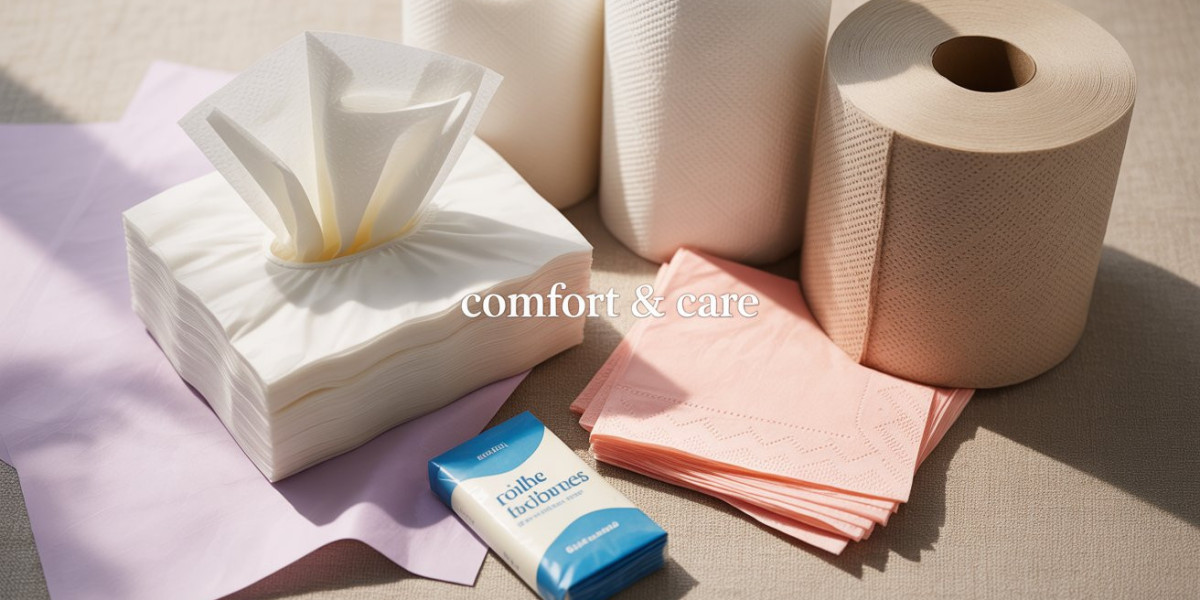Introduction to Tissue Paper and Its Growing Importance
Tissue paper, though seemingly simple, plays an essential role in modern daily life. Its presence in homes, offices, restaurants, hospitals, and various public spaces underscores its universal importance. Available in numerous varieties, tissue paper is appreciated for its absorbency, softness, convenience, and hygienic properties. From personal care to commercial cleaning, the applications of tissue paper continue to expand.
This blog explores the various categories of tissue paper commonly used today. Understanding these differences allows users to select appropriate products based on their specific needs and preferences.
Facial Tissue Paper
Facial tissue paper is perhaps the most familiar type in households. Specifically designed for delicate facial skin, these tissues are incredibly soft, lightweight, and gentle, making them ideal for wiping away sweat, tears, makeup, or any minor facial irritations. Typically packaged in boxes or pocket-sized packets, facial tissues offer convenience at home and on-the-go.
Key characteristics include:
Ultra-soft texture suitable for sensitive skin
Enhanced absorbency without harsh abrasiveness
Available in scented and unscented varieties
Often enriched with soothing ingredients like aloe vera
Toilet Tissue Paper
Toilet tissue paper is an indispensable sanitary product found in virtually every home and public restroom. Designed specifically for bathroom use, toilet tissues provide essential hygiene and comfort. They are available in various formats including single-ply, double-ply, or triple-ply, each differing in softness, strength, and absorbency.
Important aspects to consider:
Biodegradable materials for septic and plumbing system safety
Different textures and thicknesses catering to comfort preferences
Roll size variations for household or commercial use
Paper Towels or Kitchen Towels
Paper towels, also known as kitchen towels, serve multiple cleaning purposes. These tissue papers are thicker and highly absorbent, ideal for wiping spills, cleaning surfaces, drying hands, or even covering food temporarily. Commonly available in roll form, paper towels are an essential household staple for cleanliness and hygiene.
Key features of paper towels include:
Higher strength and durability for rigorous cleaning tasks
Textured surfaces enhancing absorption
Disposable nature promoting convenience and hygiene
Napkins and Serviettes
Napkins and serviettes represent another widely utilized type of tissue paper. Primarily found in dining settings such as restaurants, cafes, events, or at home, napkins provide diners with cleanliness and hygiene. Available in multiple sizes, colors, designs, and quality levels, napkins also contribute aesthetically to table settings.
Typical characteristics include:
Varied sizes suitable for casual dining or formal occasions
Customizable designs or branding possibilities for businesses
Quick absorption capability, keeping dining areas tidy
Wrapping Tissue Paper
Wrapping tissue paper differs considerably from other types, as it primarily serves decorative purposes. This thin, delicate paper is frequently used to wrap gifts, merchandise, clothing, or fragile items to protect them and enhance presentation. Wrapping tissue paper comes in various colors, patterns, and finishes, allowing creativity and personalization.
Highlighting attributes include:
Lightweight and soft texture for delicate wrapping needs
Aesthetic appeal, enhancing product or gift presentations
Customizable patterns suitable for branding or special occasions
Specialty Tissue Paper Types
Beyond standard categories, numerous specialty types of tissue paper exist, each tailored to specific purposes:
Medical-Grade Tissue Paper
Used extensively in medical environments like clinics, hospitals, and labs, medical-grade tissues maintain stringent hygiene standards. They are usually sterilized, absorbent, and disposable, ideal for procedures or examinations requiring high cleanliness.
Industrial Tissue Paper
Industrial tissues are robust and intended for heavy-duty cleaning tasks in industrial or commercial environments. They absorb oil, grease, and chemicals efficiently, suitable for factories, automotive industries, and workshops.
Hygienic Tissue Paper
Designed specifically for personal hygiene products like sanitary pads, diapers, or baby wipes, hygienic tissue papers prioritize safety, absorbency, and skin compatibility.
Factors Influencing Tissue Paper Quality
Several key factors determine tissue paper quality, influencing users' decisions based on their needs:
Ply Count: Refers to the number of layers. More layers generally imply better absorption and strength.
Absorbency: Essential for tasks like drying hands, cleaning surfaces, or personal hygiene.
Softness: Critical for sensitive skin areas such as face or personal hygiene products.
Strength: Necessary for vigorous cleaning applications or prolonged use without tearing.
Eco-friendliness: Increasing preference for recycled or biodegradable tissues, minimizing environmental impact.
Considering these factors enables informed decisions when choosing appropriate tissue products.
Environmental Considerations and Sustainable Practices
Environmental consciousness is increasingly guiding consumer choices. Sustainable practices in tissue paper production include:
Using recycled paper pulp
Sustainable sourcing certifications like FSC (Forest Stewardship Council)
Biodegradable and compostable packaging solutions
Chlorine-free bleaching processes reducing harmful chemicals
Supporting sustainable brands or products helps reduce ecological footprints without compromising daily necessities.
How Tissue Paper is Manufactured
Understanding the manufacturing process enhances appreciation for tissue paper products. Major production steps involve:
Pulping: Wood or recycled fibers processed into pulp.
Pressing and Drying: Pulp pressed, flattened, and dried to form sheets.
Creping: Adding softness and flexibility through mechanical processing.
Cutting and Packaging: Sheets cut into required dimensions and packaged accordingly.
This process ensures consistency in product quality, softness, and absorbency across various tissue types.
Selecting the Right Tissue Paper for Your Needs
Choosing the appropriate tissue paper involves several considerations:
Intended use (personal care, kitchen cleaning, gift wrapping, etc.)
Required absorbency level and strength
Sensitivity of skin or surfaces involved
Budget constraints and volume required
Environmental impact and sustainability practices
Making deliberate choices helps users optimize comfort, effectiveness, and responsible consumption.
Market Trends Influencing Tissue Paper Use
Several market trends influence demand and usage patterns for tissue paper:
Growing hygiene awareness driving increased consumption of personal care tissues
Shift toward sustainable and eco-friendly products
Customization and branding demands by businesses for napkins and wrapping tissues
Online availability and home delivery convenience encouraging bulk purchases
Keeping informed of these trends helps consumers anticipate availability, pricing, and product innovations.
Private Label and Customized Tissue Paper Products
Businesses increasingly recognize tissue paper as a branding and promotional opportunity through customized or private-label solutions. Tissue private label options allow companies to showcase their brands on napkins, facial tissues, or wrapping papers, enhancing visibility and customer recall. Restaurants, hotels, retail stores, and even healthcare providers use customized tissues to elevate customer experiences, strengthen brand identity, and maintain competitive differentiation.
This approach integrates practical functionality with strategic marketing objectives, making tissue paper an essential element in business branding strategies.







